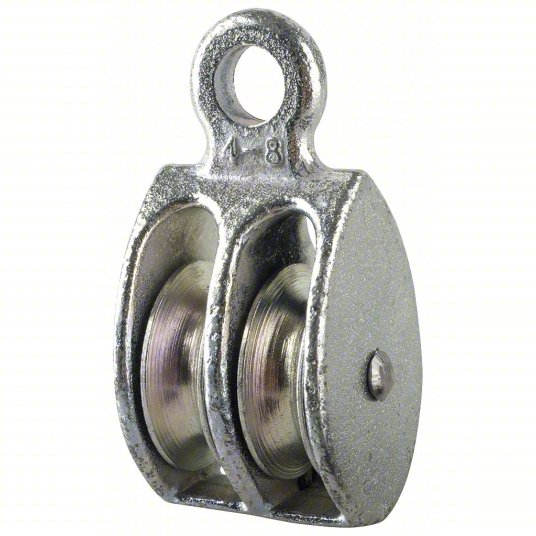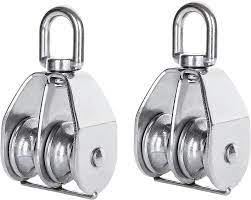Product Description
China Stainless Steel Swivel Pulley Block Double Pulley
Product Information:
| Size | A | D | L | wLL |
| mm | mm | mm | mm | T |
| 25 | 17 | 13 | 87.5 | 0.23 |
| 32 | 17 | 13 | 97.5 | 0.23 |
| 50 | 21 | 20.5 | 142 | 0.70 |
FAQ
What can we do?
1. Meet all of your lifting equipments &riggings’ needs.
2. Service on inspection for lifting equipments and rigging material.
How do you control your quality?
1.Selection of high-quality steel material from famous steel group.
2.Production process standardization, process standardization, refinement.
3.100% Finished Product Testing.
4.The third party product inspections are acceptable.
5.ISO Quality Management System Certificated Factory
6.Inspection before loading
What are your advantages compared with others?
1.Specializing in the field of lifting equipments and rigging product supply for around 10 years., have rich experience in Production.
2.The same quality product, the best price.
3.Timely Delivery with the support of 3000 square CHINAMFG workshop.
| Type: | Double Swivel |
|---|---|
| Material: | Stainless Steel |
| Sample: | Available |
| Dlivery Time: | About 30 Days |
| Swivel: | 360° Rotary Head |
| Quality: | Trademark Strictly Tested and Controlled |
| Samples: |
US$ 160/Piece
1 Piece(Min.Order) | |
|---|
| Customization: |
Available
| Customized Request |
|---|
What are some real-world examples of double pulley applications in various industries?
Double pulleys find applications in a wide range of industries due to their versatility and mechanical advantage. Here are some real-world examples of double pulley applications in various industries:
1. Construction Industry:
– Double pulleys are commonly used in the construction industry for lifting heavy materials and equipment. They are employed in crane systems, hoists, and rigging setups to enhance lifting capacity and efficiency. Double pulleys allow construction workers to move large loads with reduced effort and provide directional control for precise positioning of materials during construction projects.
2. Search and Rescue Operations:
– In search and rescue operations, double pulleys are integral to various rigging systems. They are used in highline systems, rope rescue systems, and hauling systems to lift and lower injured individuals, transport equipment, and traverse challenging terrain. Double pulleys provide mechanical advantage, load distribution, and directional control, enabling rescuers to perform complex operations efficiently and safely.
3. Mountaineering and Climbing:
– Double pulleys are extensively used in mountaineering and climbing scenarios. They are utilized in hauling systems, self-rescue setups, and ascending/descending systems. Double pulleys enable climbers to create mechanical advantage, manage rope efficiently, and change the direction of force during ascent or descent. They play a crucial role in enhancing safety and efficiency in challenging climbing environments.
4. Industrial Rigging:
– Industrial rigging operations, such as heavy machinery installation, require the use of double pulleys. They are employed in lifting systems, rigging configurations, and material handling setups. Double pulleys provide increased lifting power, load distribution, and precise control over the movement of heavy loads. Industrial rigging applications include shipbuilding, oil and gas industry, power plant maintenance, and other heavy-duty operations.
5. Entertainment and Events:
– In the entertainment and events industry, double pulleys are utilized for rigging lighting equipment, sound systems, and stage props. They allow for efficient vertical and horizontal movement of equipment, facilitating quick setup and adjustments during concerts, theater productions, and large-scale events. Double pulleys provide the necessary mechanical advantage to lift and position heavy equipment safely.
6. Arboriculture and Tree Care:
– Double pulleys play a vital role in arboriculture and tree care operations. They are used in tree climbing systems, rigging setups, and tree removal processes. Double pulleys enable arborists to lift and lower large tree limbs or trunks, safely control the descent of cut sections, and navigate complex tree structures. They provide mechanical advantage and directional control, making tree care operations more efficient and controlled.
7. Offshore and Maritime Operations:
– Double pulleys find applications in offshore and maritime operations, including ship maintenance, marine construction, and offshore platform installations. They are utilized in lifting systems, winches, and rigging configurations to handle heavy loads, position equipment, and perform maintenance tasks. Double pulleys provide the necessary mechanical advantage and load distribution for safe and efficient operations in challenging maritime environments.
8. Recreational Activities:
– Double pulleys are used in various recreational activities, such as zip-lining, rope courses, and backyard playground setups. They allow participants to traverse zip lines, navigate rope obstacles, and create fun and engaging play structures. Double pulleys provide mechanical advantage, efficient rope management, and directional control, ensuring enjoyable and safe recreational experiences.
These are just a few examples of how double pulleys are applied in various industries. Their versatility, mechanical advantage, and ability to provide load distribution and directional control make them indispensable tools in numerous applications, enhancing efficiency, safety, and productivity in a wide range of industries.
How does the arrangement of double pulleys affect their mechanical advantage?
The arrangement of double pulleys, also known as block and tackle systems or two-sheave pulleys, plays a crucial role in determining their mechanical advantage. Here is a detailed explanation of how the arrangement of double pulleys affects their mechanical advantage:
The mechanical advantage of a double pulley system is directly influenced by the number of supporting strands or “parts” of rope that are in tension. The arrangement of double pulleys refers to the configuration of pulley wheels and the path of the rope or cable within the system.
1. Fixed Pulley Arrangement:
– In a fixed pulley arrangement, one pulley is fixed to a stationary object, such as a beam or an anchor point, while the other pulley is attached to the load. The rope or cable forms a continuous loop, passing over the fixed pulley and then over the movable pulley attached to the load. This arrangement does not provide any mechanical advantage in terms of reducing the force required to lift the load. However, it changes the direction of the force, allowing for easier pulling or lifting in a different direction.
2. Movable Pulley Arrangement:
– In a movable pulley arrangement, both pulleys are attached to the load. The rope or cable forms a loop, with one end attached to a fixed point and the other end passing over the movable pulley and then attached to the load. This arrangement provides a mechanical advantage by dividing the load weight between two strands of rope. As a result, the force required to lift the load is halved compared to lifting it directly. The mechanical advantage in a movable pulley arrangement is expressed as “2:1”, indicating that the load is divided equally between the two supporting strands of rope.
3. Compound Pulley Arrangement:
– A compound pulley arrangement consists of multiple pulleys arranged in a combination of fixed and movable pulleys. The rope or cable passes over several pulleys, alternating between fixed and movable pulleys. This arrangement increases the mechanical advantage by increasing the number of supporting strands. For example, a compound pulley system with two fixed pulleys and one movable pulley provides a mechanical advantage of “3:1”, meaning the load is divided among three supporting strands of rope, reducing the force required to lift the load by one-third.
4. Multiple Blocks or Tackle Systems:
– Multiple blocks or tackle systems involve combining several double pulley arrangements to achieve even higher mechanical advantages. By incorporating additional pulleys and supporting strands, the mechanical advantage can be further increased. For instance, a system with two movable pulleys and two fixed pulleys arranged in a “4:1” configuration divides the load weight among four supporting strands, reducing the force required to lift the load by one-fourth.
It’s important to note that while the arrangement of double pulleys affects the mechanical advantage, it also impacts the distance the rope or cable must be pulled to move the load. As the mechanical advantage increases, the distance required to lift the load also increases. This trade-off between force and distance is inherent in pulley systems and should be considered when selecting the appropriate arrangement for a specific lifting task.
In summary, the arrangement of double pulleys, whether fixed, movable, compound, or multiple blocks, directly influences their mechanical advantage. The arrangement determines the number of supporting strands and the division of load weight, resulting in a reduction of the force required to lift the load. Selecting the appropriate arrangement is crucial to optimize the mechanical advantage based on the specific lifting requirements and constraints.
How does a double pulley assist in lifting and mechanical advantage?
A double pulley, also known as a block and tackle system or a two-sheave pulley, provides significant assistance in lifting heavy loads by utilizing mechanical advantage. Here is a detailed explanation of how a double pulley assists in lifting and creates a mechanical advantage:
A double pulley system consists of two pulley wheels mounted on a common axle or frame. The rope or cable that supports the load passes over both pulley wheels, creating multiple strands between the pulleys. The rope is attached to the load at one end and to an anchor point or a pulling mechanism at the other end.
The mechanical advantage provided by a double pulley arises from the redistribution of the load’s weight and the force required to lift it. When a force is applied to the free end of the rope, tension is generated along the rope’s length, including the sections passing over the pulley wheels.
The key advantage of a double pulley system is that it divides the load’s weight between the multiple strands of rope. Each strand carries a fraction of the load, reducing the force required to lift the entire weight. The mechanical advantage of a double pulley is directly proportional to the number of supporting strands or “parts” of rope that are in tension.
In a double pulley system, the mechanical advantage is typically expressed as the number of parts of rope supporting the load. For example, if a double pulley has two supporting strands, it is referred to as a “2:1” mechanical advantage system. This means that the load is divided equally between the two strands, resulting in a halving of the force required to lift the load compared to lifting it directly.
Furthermore, the mechanical advantage of a double pulley system can be increased by adding additional pulley wheels and increasing the number of supporting strands. For instance, a triple pulley system (three pulley wheels) would provide a “3:1” mechanical advantage, reducing the force required to lift the load by one-third.
It’s important to note that while a double pulley system reduces the force required for lifting, it increases the distance the rope must be pulled to move the load. This is due to the elongation of the rope caused by the multiple strands passing over the pulley wheels. The trade-off between force and distance is a fundamental characteristic of mechanical advantage in pulley systems.
In summary, a double pulley assists in lifting by redistributing the weight of the load among multiple strands of rope, thereby reducing the force required to lift the load. The mechanical advantage provided by a double pulley system is determined by the number of supporting strands, and it allows for the lifting of heavier loads with less effort compared to lifting the load directly.
editor by CX
2023-09-27



